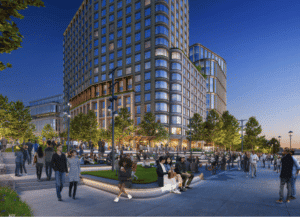A 1.1 million-square-foot Fort Point development would include more affordable housing and artist-dedicated units under changes unveiled in response to demands from neighborhood groups and Boston’s arts chief.
Related Beal said it will include 20 percent affordable housing in the residential building of its Channelside project at 244-284 A St., including up to 75 percent that will be reserved for local artists.
The increase from the previously-proposed 17.5 percent affordable housing component would create 68 income-restricted units. The artist component would create the neighborhood’s largest inventory of artist housing, Related Beal Executive Vice President Stephen Faber said in presenting the changes to a Boston Planning & Development Agency advisory group last week.
“If you really want to create a catalyst for the arts, there’s no better way to do so than actually move artists into the neighborhood: living here and engaging with the community,” Faber said.
Neighborhood arts groups protested Related Beal’s previous proposal to redevelop the former Gillette parking lot, and Boston Chief of Arts & Culture Kara Elliott-Ortega asked for additional artist housing on the site last spring.
Related Beal previously increased the proposed affordable housing component from 13 to 17.5 percent in January.
Mayor Michelle Wu has appointed a study committee on potential increases to the minimum affordability of multifamily projects in Boston, which is currently 13 percent. Major developments have agreed to exceed that level in recent proposals, including Harvard University and Tishman Speyer’s proposed Enterprise Research Campus on Western Avenue in Allston.
After researching the legal issues, Related Beal plans to deed a 1.5-acre section of the property to the city of Boston for a public park and pay for the construction and cost of operations. The park would be operated by the Boston Parks and Recreation Department.
In an interview, Tom Ready of the Fort Point Association neighborhood group said the transfer of ownership to the city of Boston is critical to ensuring the public has access to the park space. Other developments in the Seaport District have prompted complaints about insufficient public access to open space, effectively privatizing the waterfront.
“What we like to see is a public park with the city of Boston’s Park and Recreation rules. People know what they expect when they walk up to a park that’s run by the city,” Ready said.
The developer’s contribution to public art would include a $1.6 million payment upon completion of construction and $2.1 million over 10 years to pay for sculptures, rotating exhibits, furniture and performing arts programs.
The proposal also includes a pair of office-lab buildings and 3.6 acres of open space.
Related Beal bought the 6.5-acre site for $218 million in 2019 and began its permitting during former Mayor Marty Walsh’s administration. The property is one of the largest vacant parcels remaining in the Seaport, but has constraints related to zoning heights and the presence of an Interstate 90 tunnel joint located beneath the site.









